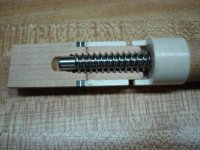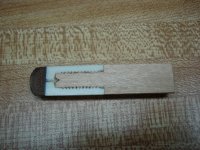Do I have to put in a dowel plug and glue it in and then re-drill and re-tap threads and put back in the insert?
Is there an easier way?
The threads in the shaft have completely stripped out the meat of the wood.
What are my options and what will a reputable cue-man charge to do the job.
PS. I have this problem in a 1992 JOSS N-4 custom cue, this is the one with the 'JOSS CUSTOM' in gold on the butt and shaft and when a proper cue is put together, everyone always asks if the names line up?
I want the cue to tighten back together, properly with the names lining up, how is this down with out breaking the collar loose and then doing the shaft pin work and then finding out where the tightened down point of the shaft to the butt is and then re-glue the collar with the 'JOSS Custom' is.
Please help, thanks
mike 'acedonkeyace' kennedy
PS. Thanks for all the info, one more question for everyone, I think that I am going to send this cue back to Dan Janes to inspect at the Joss Homeland. This cue is 20 years old now, and if you are familar with Joss cues of this vintage, the pin in the butt section has been used so infrequently, that the black covering on the pin, that gets worn off after time and repeated assemblies and dis-assemblies, looks like a brand new pins still.
Do all of you AZ'ers feel that, if Dan inspects the cue, that he should be able to tell what happened, and if it was a materials or assembly defect, should he repair for free, or should I expect to have to pay?
You opinions, will be appreciated.
thanks
'
mike
Is there an easier way?
The threads in the shaft have completely stripped out the meat of the wood.
What are my options and what will a reputable cue-man charge to do the job.
PS. I have this problem in a 1992 JOSS N-4 custom cue, this is the one with the 'JOSS CUSTOM' in gold on the butt and shaft and when a proper cue is put together, everyone always asks if the names line up?
I want the cue to tighten back together, properly with the names lining up, how is this down with out breaking the collar loose and then doing the shaft pin work and then finding out where the tightened down point of the shaft to the butt is and then re-glue the collar with the 'JOSS Custom' is.
Please help, thanks
mike 'acedonkeyace' kennedy
PS. Thanks for all the info, one more question for everyone, I think that I am going to send this cue back to Dan Janes to inspect at the Joss Homeland. This cue is 20 years old now, and if you are familar with Joss cues of this vintage, the pin in the butt section has been used so infrequently, that the black covering on the pin, that gets worn off after time and repeated assemblies and dis-assemblies, looks like a brand new pins still.
Do all of you AZ'ers feel that, if Dan inspects the cue, that he should be able to tell what happened, and if it was a materials or assembly defect, should he repair for free, or should I expect to have to pay?
You opinions, will be appreciated.
thanks
'
mike
Last edited:


